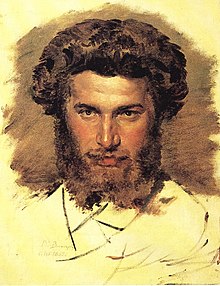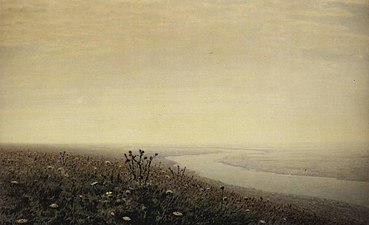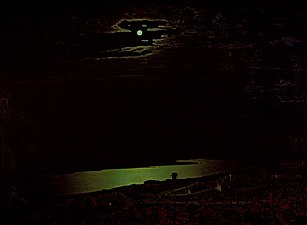Arkhip Kuindzhi
Arkhip Kuindzhi | |
|---|---|
 Portrait byViktor Vasnetsov,1869 | |
| Born | 27 January 1841 |
| Died | 24 July 1910(aged 69) St. Petersburg,Russian Empire |
| Education | Full Member Academy of Arts (1893) |
| Alma mater | Imperial Academy of Arts (1868) |
| Known for | Painting |
| Notable work |
|
| Movement | Luminism |
| Awards | Bronze Medal (London,1874) |
| Patron(s) | Pavel Tretyakov |
Arkhip Ivanovich Kuindzhi(‹See Tfd›Russian:Архип Иванович Куинджи[ɐrˈxʲipkʊˈindʐɨ];Greek:Αρχίπ Ιβάνοβιτς Κουίντζι;27 January [O.S.15 January] 1841 – 24 July [O.S.11 July] 1910) was a Russian[1][2]landscapepainterof Greek descent.[3]
Date of birth
[edit]Kuindzhi's exact date of birth is not known. Although it was believed that he was born in 1842, the latest discoveries in archives suggest that he was born in 1841. Kuindzhi himself, when asked bySt. Petersburg Academy of Artsto clarify his date of birth, "clearly wrote 1841, then, with doubt, January, and then several times crossed out the month".[4]
The researchers believe he was born somewhere between January and March 1841. The commonly recognized date is January 27, although Kuindzhi celebrated hisname dayon February 19O.S.(March 4N.S.), on the feast ofArchippus.[4][5]
Biography
[edit]Arkhip Kuindzhi was born inMariupol uezd(one of the subdivisions of theYekaterinoslav Governorateof the Russian Empire) but spent his youth in the city ofTaganrog.His Christian name is a Russian rendering of the Greek, Ἄρχιππος, (Archippos, from ἄρχος (archos) "master" and ἱππος (hippos) "horse":"master of horses "; cf. Colossians 4:17, Philemon 1:2) and his surname came from his grandfather's vocational nickname meaning 'goldsmith' inCrimean Tatar(Crimean Tatar:quyumcı).[3]He grew up in a poor family; his father was aPontic Greekshoemaker,Ivan Khristoforovich Kuindzhi (elsewhere Emendzhi). Arkhip was six years old when he lost his parents, so he was forced to make a living working at a church building site, grazing domestic animals, and working at a corn merchant's shop. He received the rudiments of an education from a Greek friend of the family who was a teacher and then went to the local school.
In 1855, at age 13–14, Kuindzhi visitedFeodosiato study art underIvan Aivazovsky;however, he was engaged merely with mixing paints,[6]and instead studied with Adolf Fessler, Aivazovsky's student.[7]A 1903 encyclopedic article stated: "Although Kuindzhi cannot be called a student of Aivazovsky, the latter had without doubt some influence on him in the first period of his activity; from whom he borrowed much in the manner of painting".[8]English art historianJohn E. Bowltwrote that "the elemental sense of light and form associated with Aivazovsky's sunsets, storms, and surging oceans permanently influenced the young Kuindzhi."[6]
During the five years from 1860 to 1865, Arkhip Kuindzhi worked as a retoucher in the photography studio of Simeon Isakovich inTaganrog.He tried to open his own photography studio, but without success. After that, Kuindzhi leftTaganrogforSaint Petersburg.
He studied painting mainly independently and at theSt. Petersburg Academy of Arts(from 1868; a full member since 1893). He was co-partner of travelling art exhibitions (Peredvizhniki), a group ofrealistartists in Russia who, in protest to academic restrictions, formed an artists' cooperative which evolved into the Society for Traveling Art Exhibitions (Peredvizhniki) in 1870.

In 1872, the artist left the academy and worked as a freelancer. The paintingOn theValaamIslandwas the first artwork whichPavel Tretyakovacquired for his art gallery. In 1873, Kuindzhi exhibited his paintingThe Snowwhich received the bronze medal at the International Art Exhibition in London in 1874. In the middle of the 1870s, he created a number of paintings in which thelandscapemotif was designed for concrete social associations in the spirit ofPeredvizhniki(Forgotten Village,1874;Chumatski Path,1875; both – in theTretyakov Gallery).
In his mature period Kuindzhy aspired to capture the most expressive illuminative aspect of the natural condition. He applied composite receptions (high horizon, etc.), creating panoramic views. Using light effects and intense colors shown in main tones, he depicted the illusion of illumination (Evening in Ukraine,1876;A Birch Grove,1879;After a Thunderstorm,1879; all three are in the Tretyakov Gallery;Moonlit Night on the Dnieper,1880 in theRussian Museum,St. Petersburg). His later works are remarkable for their decorative effects of color building.
Kuindzhi also developed a close friendship with the chemistDmitri Mendeleev,[9]who taught atSaint Petersburg University.Kuindzhi attended his classes as an auditor or student. Kuindzhi frequently visited Mendeleev and his wife's weekly gatherings, and he developed a life-long interest in the study of light, color, and perception.[10]
Kuindzhi lectured at theSt. Petersburg Academy of Arts(Professor since 1892; professor-head of landscape workshop since 1894; but was fired in 1897 for support of students' protests). Among his students were artists such asArkady Rylov,Nicholas Roerich,Konstantin Bogaevsky,and others. Kuindzhi initiated the creation of the Society of Artists in 1909, later the Society was named after him.
Theft of works
[edit]In January 2019, his workAi-Petri. Crimeawas stolen from Moscow'sTretyakov Gallery,but was found and safely recovered the next day.[11]The man who stole the painting was sentenced to three years in prison.[12]
On 21 March 2022, during theRussian invasion of Ukraine,theKuindzhi Art Museumwas destroyed in a Russian airstrike during thesiege of Mariupol.None of Kuindzhi's original works were in the museum at the time, but the fate of paintings by other artists remains unknown.[13][14]Although three original paintings by Kuindzhi that had been held in the collection—a sketch forRed Sunset,and two preparatory works,ElbrusandAutumn—had been removed from the museum prior to the bombing, they were then taken by Russia as part of itslooting campaign.[15][16][17]
Tribute
[edit]On 27 January 2022,Google Doodlecelebrated Arkhip Kuindzhi's 180th birthday.[18][19]
Gallery
[edit]-
Lake Ladoga(1873)
-
A Birch Grove(1879)
-
Dnieperin the Morning(1881)
-
Surf and Clouds(1882)
-
Elbrus(1890–1895)
-
Evening in Ukraine(1878–1901)
-
Moonspots in the Forest, Winter(1898–1908)
See also
[edit]References
[edit]- ^"Письма Въ Редакцiю".Novoye Vremya(in Russian). No. 10055. March 15, 1904. p. 5.RetrievedSeptember 12,2024– viaBibliothèque nationale de France.Я принужденъ заявить многоуважаемому г. Меньшикову, что я—русскій. Предки мои греки, которые еще при императрицѣ Екатеринѣ переселились съ южнаго берега Крыма и основали городъ Маріуполь и 24 деревни. Все сказанное мною подтвердитъ многоуважаемому г. Меньшикову мой землякъ Эльпе (Л. Поповъ), сотрудникъ „Новаго Времени “, съ которымъ я знакомъ съ дѣтства. А. Куинджи. 1 марта 1904 г.[I am forced to declare to the highly respectedMr. Menshikovthat I am Russian. My ancestors are Greeks, who during the time ofEmpress Catherinemoved from the southern coast ofCrimeaand founded the city ofMariupoland 24 villages. My fellow countrymanElpe (L. Popov),an employee ofNovoye Vremya,whom I have known since childhood, will confirm everything I have said to the highly respected Mr. Menshikov. A. Kuindzi. 1 March 1904.]
- ^"Смѣхъ и Горе".Mir iskusstva(in Russian). No. 3. 1904. p. 73.RetrievedSeptember 11,2024– viaNekrasov Central Library.
- ^ab"Biography of Arkhip Ivanovich Kuinji (1842-1910), Russian Artist".2000.Retrieved8 May2021.
- ^abМарина Молошна (January 27, 2022)."Що не так з датою народження Куїнджі, та чому Google помилився, привітавши всіх з його 180-річчям".www.0629.com.ua(in Ukrainian). 0629.com.ua.RetrievedJanuary 27,2022.
- ^"27 січня 1841 року народився український живописець-пейзажист Архип Куїнджі".dn.gov.ua(in Ukrainian).Governor of Donetsk Oblast.January 27, 2022.
- ^abBowlt, John E.(1975). "A Russian Luminist School? Arkhip Kuindzhi's" Red Sunset on the Dnepr "".Metropolitan Museum Journal.10.Metropolitan Museum of Art:123–125.doi:10.2307/1512704.JSTOR1512704.S2CID192949837.
- ^Manin, Vitaly[in Russian](2000).Архип Куинджи(in Russian). Moskva: Belyĭ gorod. p. 6.ISBN978-5-7793-0219-7.
в Феодосию к знаменитому Айвазовскому. Куинджи прибыл в тихую Феодосию, по-видимому, летом 1855 года.... Устройством Куинджи занялся Адольф Фесслер, ученик и копиист Айвазовского. Жил Архип во дворе под навесом в...
- ^"Куинджи Архип Иванович".Russian Biographical Dictionary(in Russian). Saint Petersburg:Imperial Russian Historical Society.1903.
Хотя Куинджи и нельзя назвать учеником Айвазовского, но последний имел на него, несомненно, некоторое влияние в первый период его деятельности; от него он заимствовал многое в манере писать, в выборе тем, в любви к широким пространствам.
online view - ^Gordin, Michael D. (2019).A well-ordered thing: Dmitrii Mendeleev and the shadow of the periodic table(Revised ed.). Princeton. p. 182.ISBN9780691172385.
{{cite book}}:CS1 maint: location missing publisher (link) - ^Paranyuk, Viktoria (2019). "Painting Light Scientifically: Arkhip Kuindzhi's Intermedial Environment".Slavic Review.78(2): 456–480.doi:10.1017/slr.2019.97.S2CID201412836.
- ^"Painting stolen in Tretyakov Gallery heist 'not damaged', source says".TASS.
- ^"Three Years For Stealing Painting From Moscow's Tretyakov Gallery".rferl.org.25 September 2019.
- ^"Mariupol museum dedicated to 19th-century artist Arkhip Kuindzhi destroyed by airstrike".The Art Newspaper.23 March 2022. Archived fromthe originalon 2022-03-26.Retrieved25 March2022.
- ^"In Mariupol occupiers destroyed an art museum that housed original works by Aivazovsky".Hromadske Radio.24 March 2022. Archived fromthe originalon 2022-04-01.Retrieved2022-04-01.
- ^Sorokina, Yanina (2022-07-06)."How Russia 'Removed' Priceless Kuindzhi Artworks from Ukraine's Mariupol".The Moscow Times.Retrieved2023-03-24.
- ^"Culture war: Russia ransacks art to rub out Ukraine's history".POLITICO.2022-12-06.Retrieved2023-03-24.
- ^Bushard, Brian (2023-01-14)."These Are Some of the Most Famous Ukrainian Works of Art Looted by Russia".Forbes.Retrieved2023-03-25.
- ^"27 January: Remembering Arkhip Kuindzhi on Birthday".Observer Voice.2023-01-26.Retrieved2023-01-26.
- ^"Arkhip Kuindzhi's 180th Birthday".www.google.com.Retrieved2023-01-26.
- V.S. ManinArkhip Ivanovich Kuinji,Leningrad, 1990,ISBN5-7370-0098-2
External links
[edit]- Full Members of the Imperial Academy of Arts
- Imperial Academy of Arts alumni
- 1841 births
- 1910 deaths
- People from Mariupol
- People from Yekaterinoslav Governorate
- People from the Russian Empire of Greek descent
- Peredvizhniki
- Landscape painters from the Russian Empire
- 19th-century painters from the Russian Empire
- Russian male painters
- 20th-century Ukrainian painters
- Burials at Tikhvin Cemetery
- 19th-century male artists from the Russian Empire
- Artists from Taganrog









